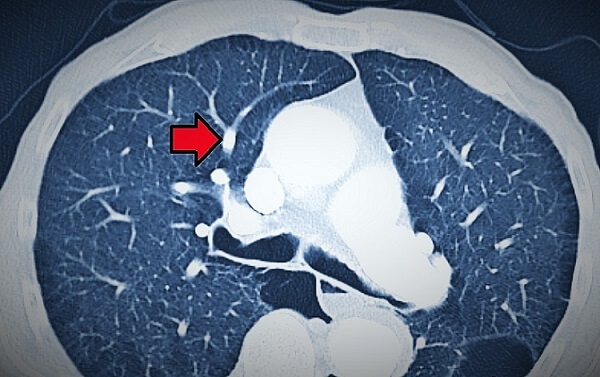Just in case you want your doctor to look at this for you.
https://www.mdlinx.com/internal-medicine/article/464/ZZ5E7140FC880A49D2B09335E79A960EBE?
Elevated serum levels of a specific protein—hematoma derived growth
factor (HDGF)—predicted the severity and survival for patients with
pulmonary arterial hypertension (PAH), according to a study published
June 2, 2016 in American Journal of Respiratory and Critical Care Medicine.
This discovery may lead to a more specific, noninvasive test
that could help doctors to detect and monitor PAH, as well as decide the
best treatment for a patient with the progressive, incurable disease.
Currently, patients often aren’t diagnosed until they’re in the final
stages of the disease.
“This has the potential to be a much more specific readout for the
health of the lungs than what we currently measure using invasive
cardiac catheterization,” said senior study
author Allen Everett, MD, Professor of Pediatrics and Director of the
Pediatric Proteome Center at the Johns Hopkins University School of
Medicine, in Baltimore, MD.
“It could really have value in making decisions about when to
escalate therapy and when to ease it because, at present, it’s difficult
to determine whether someone’s disease is getting better or worse,
especially in children,” Dr. Everett added.
HDGF is a protein involved in new blood vessel formation, which is
known to occur in the lungs of patients with PAH. For this study, the
researchers developed a new enzyme-linked immunosorbent assay (ELISA) to
measure serum levels of HDGF.
The investigators collected blood samples from 39 patients with
severe PAH who had failed conventional treatment and were waiting for
lung transplants. They compared these with a control group of 39 age-,
gender-, and race-matched healthy volunteers.
Results showed that PAH patients had median HDGF levels that were
about 7 times higher (1.93 ng/ml) than HDGF levels in control subjects
(0.29 ng/ml).
The researchers investigated further by testing HDGF levels in a
validation cohort of 73 additional patients with PAH. The results were
dramatic, Dr. Everett said. Patients with an HDGF level greater than 0.7
ng/ml had more extensive heart failure and couldn’t walk as far in the
6-minute walking test.
“Thus, patients with higher HDGF had worse functional status and diminished functional capacity,” the authors wrote.
HDGF was also higher in non-survivors (1.4 ng/ml) than in survivors
(0.2 ng/ml). Even after adjusting for age, PAH subtype, and other
factors, elevated levels of HDGF were associated with a 4.5-fold
increased risk of death.
These findings suggest that HDGF has a distinct advantage over
current clinical measures for predicting survival in patients with
pulmonary hypertension, Dr. Everett noted.
“This could be a cheap and easy way to say, ‘Oh, good, your levels
are going down. Let’s try to take away one of your medicines and see how
that works,’” he said. “Or if you know from the very beginning of their
treatment that someone isn’t responding to any medicines, you can get
them on the list for a lung transplant much sooner.”
More research is needed to find out whether HDGF levels change as
drug treatment eases symptoms, whether the results hold true in children
with PAH, and whether HDGF can be used to predict PAH in patients at
risk of developing the disease in the future, the researchers
acknowledged.
Use the labels in the right column to find what you want. Or you can go thru them one by one, there are only 29,061 posts. Searching is done in the search box in upper left corner. I blog on anything to do with stroke.DO NOT DO ANYTHING SUGGESTED HERE AS I AM NOT MEDICALLY TRAINED, YOUR DOCTOR IS, LISTEN TO THEM. BUT I BET THEY DON'T KNOW HOW TO GET YOU 100% RECOVERED. I DON'T EITHER, BUT HAVE PLENTY OF QUESTIONS FOR YOUR DOCTOR TO ANSWER.
Changing stroke rehab and research worldwide now.Time is Brain! trillions and trillions of neurons that DIE each day because there are NO effective hyperacute therapies besides tPA(only 12% effective). I have 523 posts on hyperacute therapy, enough for researchers to spend decades proving them out. These are my personal ideas and blog on stroke rehabilitation and stroke research. Do not attempt any of these without checking with your medical provider. Unless you join me in agitating, when you need these therapies they won't be there.
What this blog is for:
My blog is not to help survivors recover, it is to have the 10 million yearly stroke survivors light fires underneath their doctors, stroke hospitals and stroke researchers to get stroke solved. 100% recovery. The stroke medical world is completely failing at that goal, they don't even have it as a goal. Shortly after getting out of the hospital and getting NO information on the process or protocols of stroke rehabilitation and recovery I started searching on the internet and found that no other survivor received useful information. This is an attempt to cover all stroke rehabilitation information that should be readily available to survivors so they can talk with informed knowledge to their medical staff. It lays out what needs to be done to get stroke survivors closer to 100% recovery. It's quite disgusting that this information is not available from every stroke association and doctors group.
Subscribe to:
Post Comments (Atom)

No comments:
Post a Comment